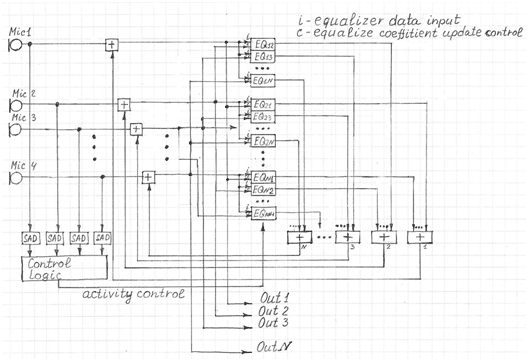An acoustic multiple-channel crosstalk canceller is used with multi-microphone systems to reduce the mutual leakage and extract clean signals for each acoustic source.

A Crosstalk Canceller that reduces the mutual leakage and extracts clean signals of each source is represented in Fig.1. It is based on two NLMS equalizers that minimize the leakage power from one source to another one and vice versa. Each of the equalizer coefficient updates is set on and off by its own control signal.
It is assumed that there are multiple acoustic sources. Each source is located nearby a microphone dedicated to that source. It means that the n-th (n = 1,…N, N – number of microphones) microphone receives high level of signal n and some low level leakage from the rest of the sources.
Each leakage source could be delayed by a propagation amount of time. Moreover in a multipath propagation environment, each leakage source may be reflected from different objects and come to the microphone as a sum of leakage sources with different delays and weights. Each multipath propagation could be described by its own FIR filter.
Control signals are generated by the logic block from the Source Activity Detectors (SAD) signals. SAD estimates the level of the signal at the output of each microphone. It is assumed that the biggest fraction of the power at the output of the microphone is contributed from the signal dedicated to this microphone and only a small fraction of the power from leakage signals of other sources.